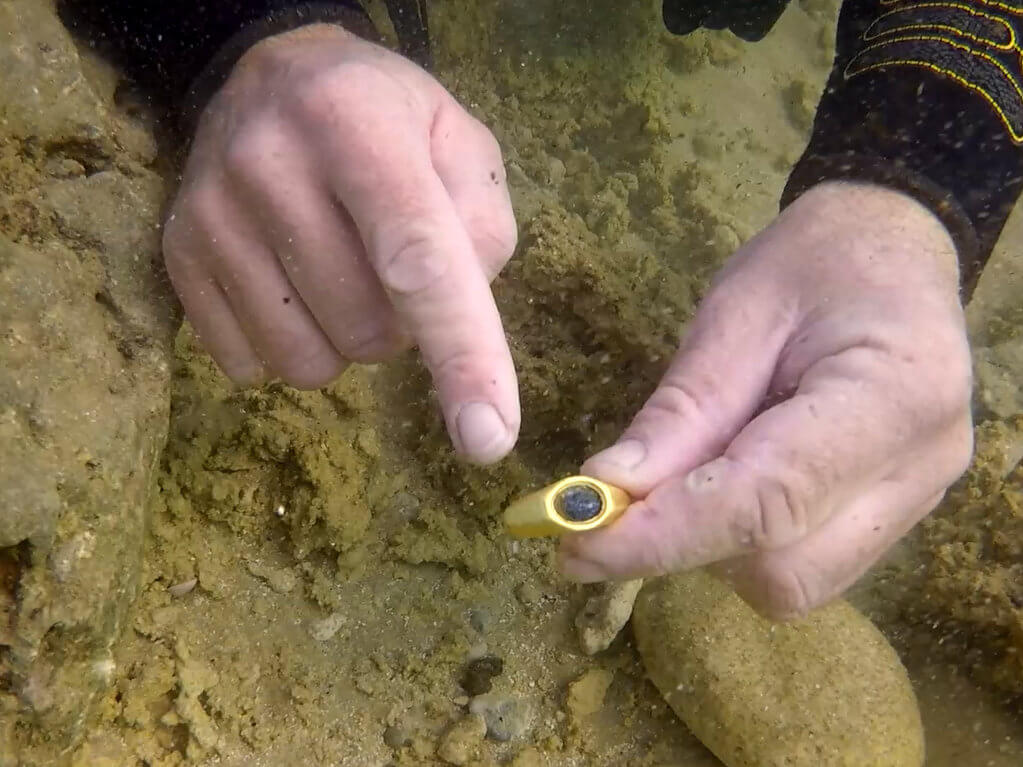A maritime archaeological survey by the Antiquities Authority in Caesarea revealed a treasure of two ancient shipwrecks, including hundreds of silver coins, gold and silver rings, rare decorated gems, an eagle statuette, bells, and parts of a ship. According to the researchers of the Maritime Archeology Unit at the Antiquities Authority: "The findings tell the story of two ships that were wrecked, along with their passengers, at different times, probably while trying to anchor or find shelter from a storm"

Magnificent items that were wrecked from two ships that crashed off the coast of Caesarea during the Roman and Mamluk periods (about 1700 years ago and about 600 years ago), were revealed in an underwater survey conducted by the Maritime Archeology Unit of the Antiquities Authority in recent months. The ship's cargo assemblies and the remains of their fragments were found scattered in shallow water, at a depth of about 4 m, over an area of several tens of meters.
According to Yaakov Sharvit and Dror Flaner, researchers of the Maritime Archeology Unit at the Antiquities Authority, "It seems that the ships were anchored nearby, and a storm that occurred caused them to sink. It is possible that the mooring was carried out out of distress or fear of a storm, because the seafarers know that mooring in the shallow waters other than in a built and orderly harbor is dangerous and prone to disaster."
The maritime treasure includes hundreds of silver coins (about 560 coins of which about 160 are cut coins) from the Mamluk period and hundreds of silver and bronze coins from the Roman period, a bronze statuette in the form of an eagle - the symbol of the Roman government, a statuette of a pantomime actor in a mask from the Roman comedy, many bells made Bronze intended, among other things, to drive away evil spirits, and pottery. In addition, many metal parts belonging to a wooden ship's hull were discovered, including dozens of large bronze nails, lead pipes belonging to a water pump, and a large anchor made of iron, which broke - indicating the great force that acted on it until it broke, apparently in a storm.
From the ships, rare personal items of people who were on them were also swept into the sea, but did not survive. Among other things, a red gemstone was uncovered, intended for setting in a ring (gamma), on which a musical instrument known by various names was engraved - the most prominent of which is the lyre, and in the Jewish tradition - David's violin. According to the Book of Samuel XNUMX:XNUMX, King David played David's violin for King Saul (and it happened that the Spirit of God was upon Saul, and David took the violin, and played in his hand; and it came to Saul and it was good for him, and an evil spirit departed from him.) According to accepted research, the same violin mentioned in the Bible is, in fact, the lyre instrument, known in Greek mythology as "Apollo's lyre". According to this story, Hermes built the musical instrument - the lyre, from a tortoise shell, the morning he was born. In exchange for this musical instrument, Apollo, who was a lover of music, agreed to turn Hermes and his mother into gods.
Another important item is a thick gold ring, designed in an octagonal shape and set with a green gemstone, on which is carved the figure of a young boy, a "shepherd" dressed in a tunic, carrying a ram or sheep on his shoulders. This image, of the 'Good Shepherd', is recognized in early Christian art as a symbol of Jesus; This is a parable for Jesus as the merciful shepherd of mankind, or as one who spreads protection over the person or his congregation of believers. Interestingly, the unique gold ring, bearing the figure of the shepherd
The good, was discovered in the vicinity of the city of Caesarea, which is known to have great significance in the Christian tradition. In Caesarea, one of the earliest centers of Christianity took shape, and one of the first Christian communities operated there. In the beginning, only Jews were included in this community. According to the New Testament, in Caesarea the apostle Peter baptized the Roman centurion Cornelius. "This is the first case in which a non-Jewish person was brought under the wings of Christianity," says Sharvit. "Here, the Christian religion began its way around the world." It is believed that the owner of the revealed ring was one of the first Christians.
According to Eli Escozido, director of the Antiquities Authority, "The shores of the Land of Israel are rich in ancient sites and findings, which are of great importance as national and international heritage cultural assets. These are exposed to dangers, which is why the Antiquities Authority conducts underwater surveys to locate, monitor and save the antiquities. Many sporting activities are held along the coasts of Israel - diving, snorkeling, open sea swimming and sailing, during which antiquities are discovered from time to time. We turn to the divers and ask - if you come across antiquities, take a location point in the sea, leave the findings in the water and report to us immediately. The discovery and documentation of the findings in situ is of great archaeological importance, and sometimes even a small find leads to a big discovery."
